Enhanced TDS
Identification & Functionality
- Chemical Family
- RTU Product Type
- Technologies
- Product Families
Features & Benefits
- Ready-to-Use Product Features
- Key Benefits
- Under water and in humid areas
- Virtually no surface preparation
- Outstanding adhesion on dissimilar substrates
- Temperature resistance up to 120°C
- Product Features
- Ultra-fast curing from -20°C to 25°C (-4°F to 75°F)
- Application and curing under water (including salt water) and humid areas
- Excellent bond to a wide range of plastics, composites and metals
- Minimum substrate pretreatment needed
- Suitable for service at temperatures up to 120°C (250°F)
- Excellent ageing and weathering resistance
Applications & Uses
- Application Area
- Compatible Polymers & Resins
- Compatible Substrates & Surfaces
- Markets
- Applications
- Processing Information
Pretreatment
The strength and durability of a bonded joint are dependent on proper treatment of the surfaces to be bonded. At the very least, joint surfaces should be cleaned with a good degreasing agent such as acetone, isopropanol (for plastics) or other proprietary degreasing agents in order to remove all traces of oil, grease and dirt. Low-grade alcohol, gasoline, or paint thinners should never be used. The strongest and most durable joints are obtained by either mechanically abrading or chemically etching (“pickling”) the degreased surfaces. Abrading should be followed by a second degreasing treatment.
ARALDITE® 2050 A/B structural adhesive is available in cartridges incorporating mixers and can be applied as ready to use adhesive with the aid of the tool recommended by Huntsman Advanced Materials.
Application of adhesive
This system is available in cartridges incorporating mixers and can be applied as ready to use adhesive with the aid of the tool recommended by Huntsman Advanced Materials. The resin/hardener mix may be applied manually or robotically to the pretreated and dry joint surfaces. Huntsman's technical support group can assist the user in the selection of a suitable application method as well as suggest a variety of reputable companies that manufacture and service adhesive dispensing equipment. A layer of adhesive 0.25 mm thick will normally impart the greatest lap shear strength to the joint. The joint components should be assembled and secured in a fixed position as soon as the adhesive has been applied. For more detailed explanations regarding surface preparation and pretreatment, adhesive joint design, and the dual cartridge dispensing system.
Temperature of application: the recommended temperature application range is -20°C to 25°C (-4°F to 77°F). If the adhesive is used at a temperature above 25°C (77°F), because of the fact reaction, the viscosity will increase so rapidly that a good wetting of the substrate will be difficult to achieve. Therefore above 25°C (77°F), the performance of the bond may be limited. For higher application temperatures, the Araldite® 2051 may be preferred.
WARNING! The cure reaction can generate a high amount of heat, it is not recommended to mix large amounts of material at room temperature
Temperature
-20C (-4°F)
-10C (14"F)
0C (32°F)
10℃ (50°F)
23C (73°F)
>1MPa (145 psi)
4h
90 min
40 min
12 min
9 min
>10MPa (1,450 psi)
8 h
3 h
1h
20 min
13 min
Equipment Maintenance
All tools should be cleaned with hot water and soap before adhesives residues have had time to cure. The removal of cured residues is a difficult and time-consuming operation. If solvents such as acetone are used for cleaning, operatives should take the appropriate precautions and, in addition, avoid skin and eye contact.
Technical Details & Test Data
- Graphical Data
Fixture time at different temperatures
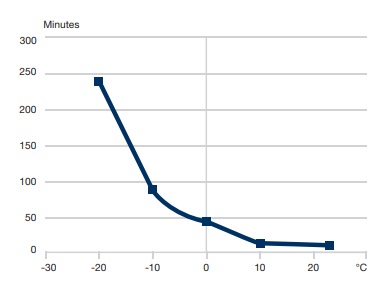
Lap Shear Strength at 23°C, ISO 4587
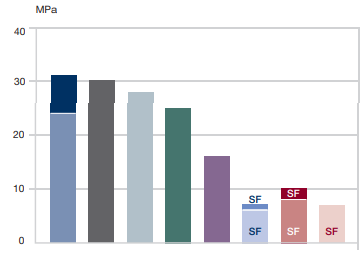
Lap Shear Strength after ageing Cataplasma ageing: ISO 9142-E2
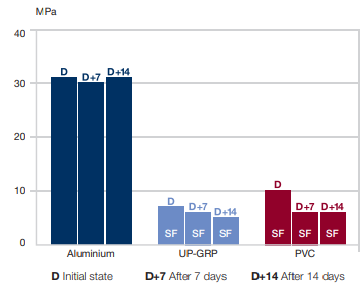
- Processing Condition
- Pretreatment : The strength and durability of a bonded joint are dependent on proper pretreatment of the surfaces to be bonded, however the methacrylate adhesives can be used effectively with little surface preparation. Ideally joint surfaces should be cleaned with a good degreasing agent such as acetone, iso-propanol (for plastics) or other proprietary degreasing agents in order to remove all traces of oil, grease and dirt. Low grade alcohol, gasoline (petrol) or paint thinners should never be used. The strongest and most durable joints are obtained by either mechanically abrading or chemically etching (“pickling”) the degreased surfaces.
Mix ratio Parts by weight Parts by volume Resin 100 100 Hardener 100 100 - Application of adhesive: This system is available in cartridges incorporating mixers and can be applied as ready to use adhesive with the aid of the tool recommended by Huntsman Advanced Materials. The resin/hardener mix may be applied manually or robotically to the pretreated and dry joint surfaces. Huntsman's technical support group can assist the user in the selection of a suitable application method as well as suggest a variety of reputable companies that manufacture and service adhesive dispensing equipment. A layer of adhesive 0.25 mm thick will normally impart the greatest lap shear strength to the joint. The joint components should be assembled and secured in a fixed position as soon as the adhesive has been applied.
- Temperature of application: the recommended temperature application range is -20°C to 25°C. If the adhesive is used at a temperature above 25°C, because of the fact reaction, the viscosity will increase so rapidly that a good wetting of the substrate will be difficult to achieve. Therefore above 25°C, the performance of the bond may be limited. For higher application temperatures, the Araldite® 2051 may be preferred. Warning: the cure reaction can generate a high amount of heat, it is not recommended to mix large amounts of material at room temperature.
- Equipment maintenance: All tools should be cleaned with hot water and soap before adhesives residues have had time to cure. The removal of cured residues is a difficult and time-consuming operation. If solvents such as MEK are used for cleaning, operatives should take the appropriate precautions and, in addition, avoid skin and eye contact.
Temperature °C -20°C -10°C 0°C 10°C 15°C 23°C Cure time to reach hours 4 LSS > 1 MPa minutes 90 40 12 11 9 Cure time to reach hours 8 3 1 LSS > 10 MPa minutes 20 16 13 - Typical Cured Properties
- Unless otherwise stated, the figures given below were all determined by testing standard specimens made by lap- jointing 114 x 25 x 1.6 mm strips. The joint area was 12.5 x 25 mm in each case. The figures were determined with typical production batches using standard testing methods.
Average lap shear strengths of typical metal-to-metal joints (ISO 4587) (typical average values)
Cured for 24 hours at RT and tested at 23C, sandblasted and degreased with acetone or only degreased with acetone.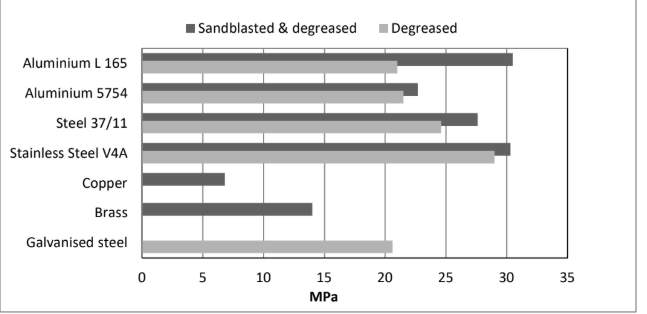
Notes: Araldite® 2050 is not suitable to bond copper or brass without surface preparation. Galvanised steel should not be abraded or sandblasted, better results are obtained with only degreasing.
Average lap shear strengths of typical plastic-to-plastic joints (ISO 4587) (typical average values)
Cured for 24 hours at RT and tested at 23C. Abraded and degreased with isopropanol or only degreased with isopropanol.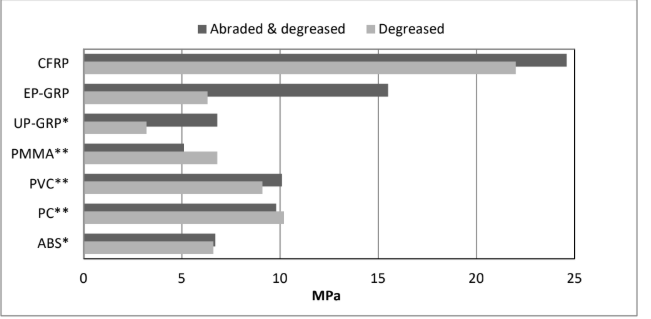
(*): UP-GRP, ABS, substrate failure observed when abraded and degreased.
(**) : PMMA, PVC, PC, substrate failure observed in all conditions.Average lap shear strengths on aluminium after bonding and cure at low temperature (ISO 4587) (typical average values)
Bonded and cured at the temperatures indicated below. Test on aluminium sandblasted and degreased. Tested at 23°C just after release of the specimens from the climatic chamber.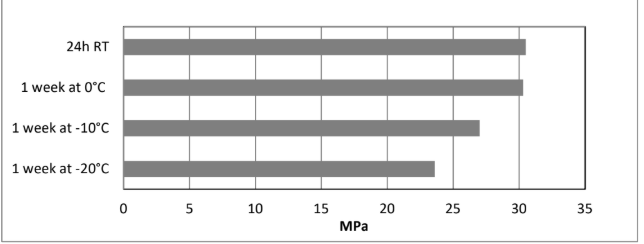
Average lap shear strengths after application, bonding and curing under water (ISO 4587) (typical average values)
Cure 24 hours under water at RT.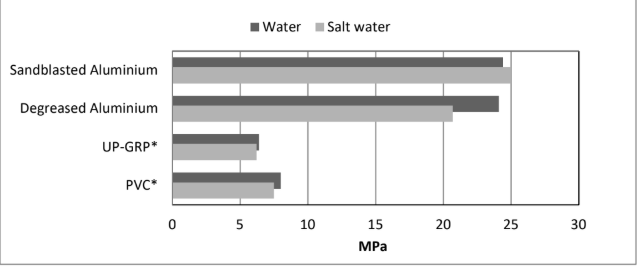
(*): UP-GRP, PVC, substrate failures observed.
Lap shear strength versus temperature (ISO 4587) (typical average values)
On aluminium, pretreatment: sand blasting. Cure: 24 hours at RT.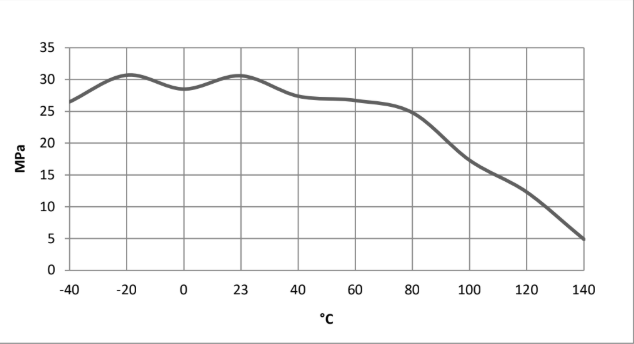
Lap shear strength versus immersion in various media (ISO4587) (typical average values)
On aluminium, pretreatment: sand blasting. Cure: 24 hours at RT Tested at 23°C. LSS. was determined after immersion for 30 days at 23°C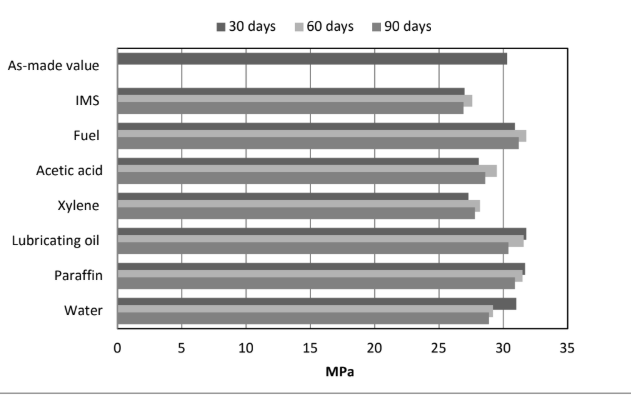
Lap shear strength versus heat ageing and thermal cycling (typical average values)
Cure: 24 hour at RT. Test at 23°C
Thermal cycling 100 cycles ( 2h -30°C / 1 h up to 70°C / 2h 70°C / 1h down to -30°C)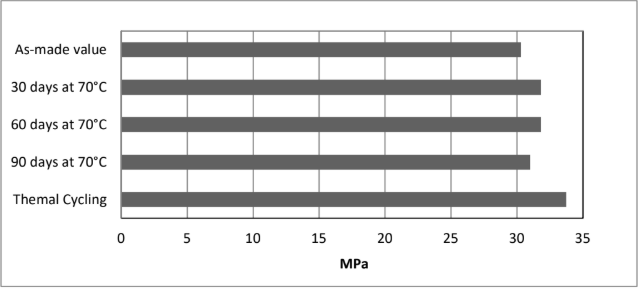
Lap shear strength versus Cataplasma ageing (typical average values)
Cure 24 hours at RT – Cataplasma according to ISO 9142/E2 - Test: at 23°C
Metals sandblasted and degreased / plastics abraded and degreased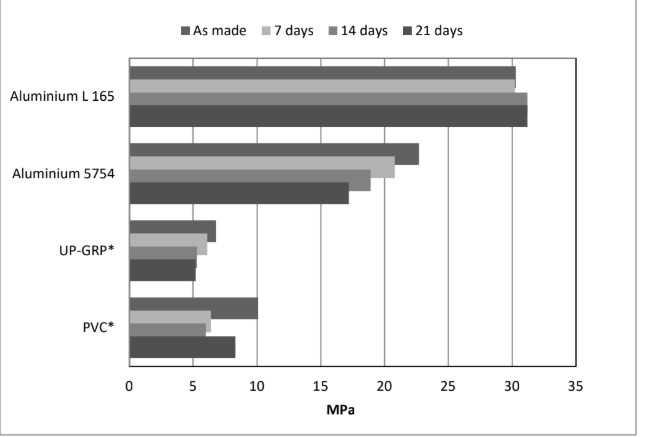
- Typical Physical Properties
Unless otherwise stated, the data were determined with typical production batches using standard test methods. They are typical values only, and do not constitute a product specification. Unless a different specification is given, the figures below were all determined by testing standard specimens made by lap-jointing 4.5 x 1 x 0.063 in (114 x 25 x 1.6 mm) strips. The joint area was 0.5 x 1 in (12.5 x 25 mm) in each case.
Average lap shear strength (ASTM D1002), metal-metal joints. Substrates degreased with IPA
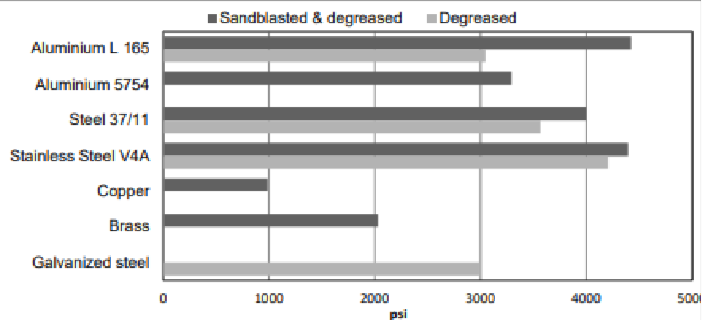
Notes: ARALDITE® 2050 is not suitable to bond copper or brass without surface preparation. Steels should not be abraded or sandblasted, better results are obtained with only degreasing.
Lap shear strength (ASTM D1002) versus temperature (typical average values). On aluminum, pretreatment: sand blasting. Cured 24 hours at 23°C (73°F).
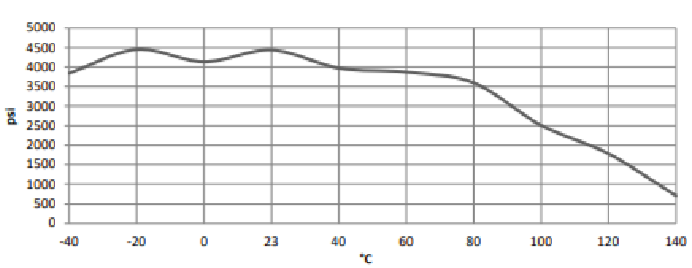
Average lap shear strengths (ASTM D1002) on aluminum after bonding and cure at low temperature (typical average values). Bonded and cured at the temperatures indicated below. Test on aluminum sandblasted and degreased. Tested at 23°C (73°F) just after release of the specimens from the climatic chamber.

Average lap shear strengths (ASTM D1002) after application, bonding and curing under water (typical average values). Cured 24 hours under water at 23°C (73°F)

(*): UP-GRP, PVC, substrate failures observed
Average lap shear strength (ASTM D3163), plastic-plastic joints. Substrates were lightly abraded and degreased with IPA.
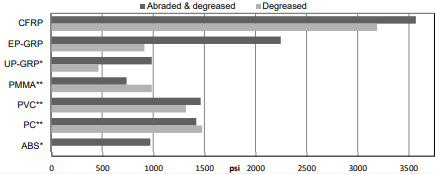
(*): UP-GRP, ABS, substrate failure observed when abraded and degreased.
(**) : PMMA, PVC, PC, substrate failure observed in all conditions.Lap shear strength (ASTM D1002) versus immersion in various media (typical average values) Substrate: sand blasted aluminum. Cured 24 hours at RT. Tested at 23°C (73°F). Lap shear strength was determined after immersion for 30 days at 23°C (73°F).
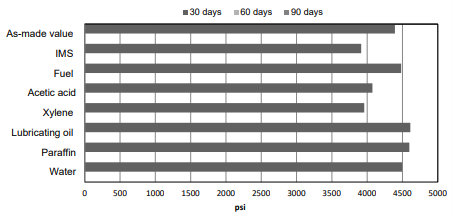
Lap shear strength (ASTM D1002) versus Cataplasma ageing (typical average values). Cure 24 hours at 23°C (73°F) – Cataplasma according to ISO 9142/E2. Tested at 23°C (73°F). Metals sandblasted and degreased / plastics abraded and degreased.
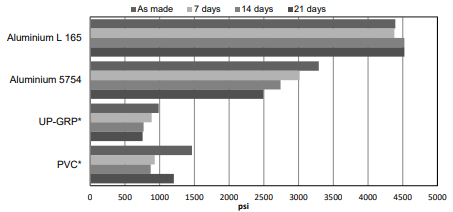
Lap shear strength (ASTM D1002) versus heat ageing and thermal cycling (typical average values). Cured 24 hours at 23°C (73°F). Tested at 23°C (73°F). Thermal cycling 100 cycles ( 2h at - 30°C (-22°F) --> 1 h ramp up to 70°C (158°F) --> 2h 70°C (158°F) --> 1h ramp down to -30°C (-22°F))

Packaging & Availability
- Packaging Type
Storage & Handling
- Storage Conditions
- Araldite® 2050 may be stored during 24 months at 2 – 8°C provided the components are stored in the original sealed containers.
- The expiry date is indicated on the packaging.
- The product may be placed at room temperature before use, the total time at room temperature should not exceed 9 months.
- Long term exposure above 25°C will reduce the shelf life of the product.
Other
- Appearance
- Pale yellow
- Physical Properties
Value Units Test Method / Conditions Density 1.0 g/cm³ g/cm³
